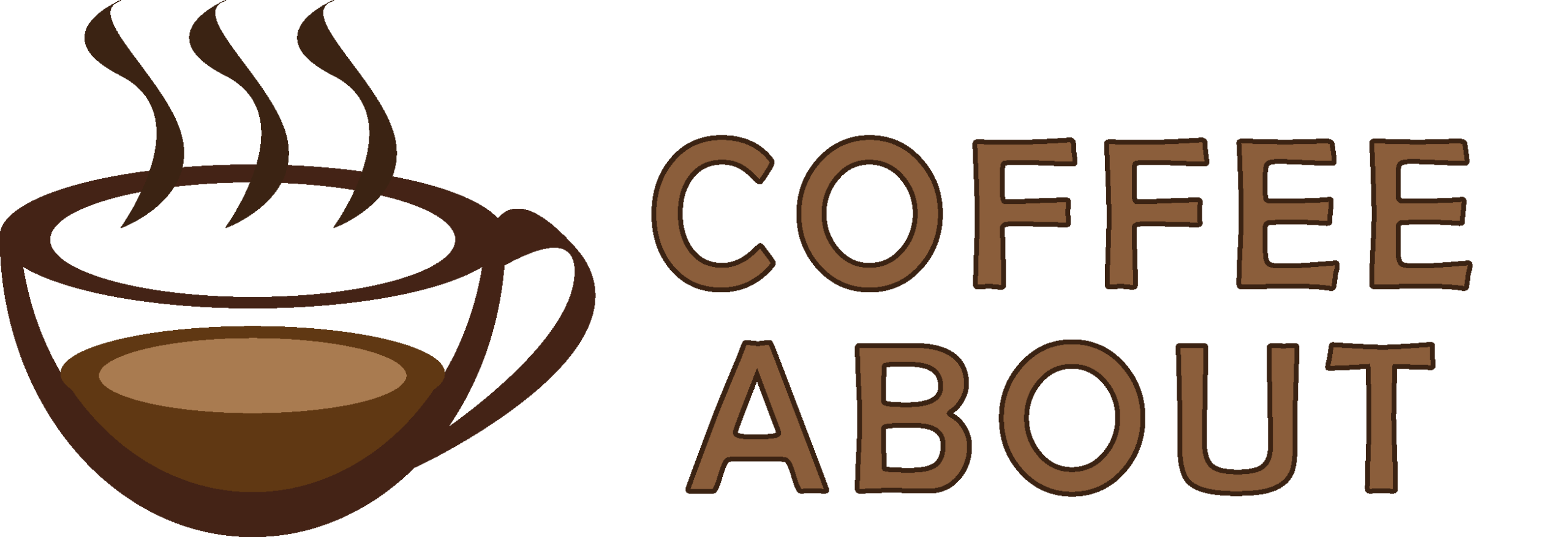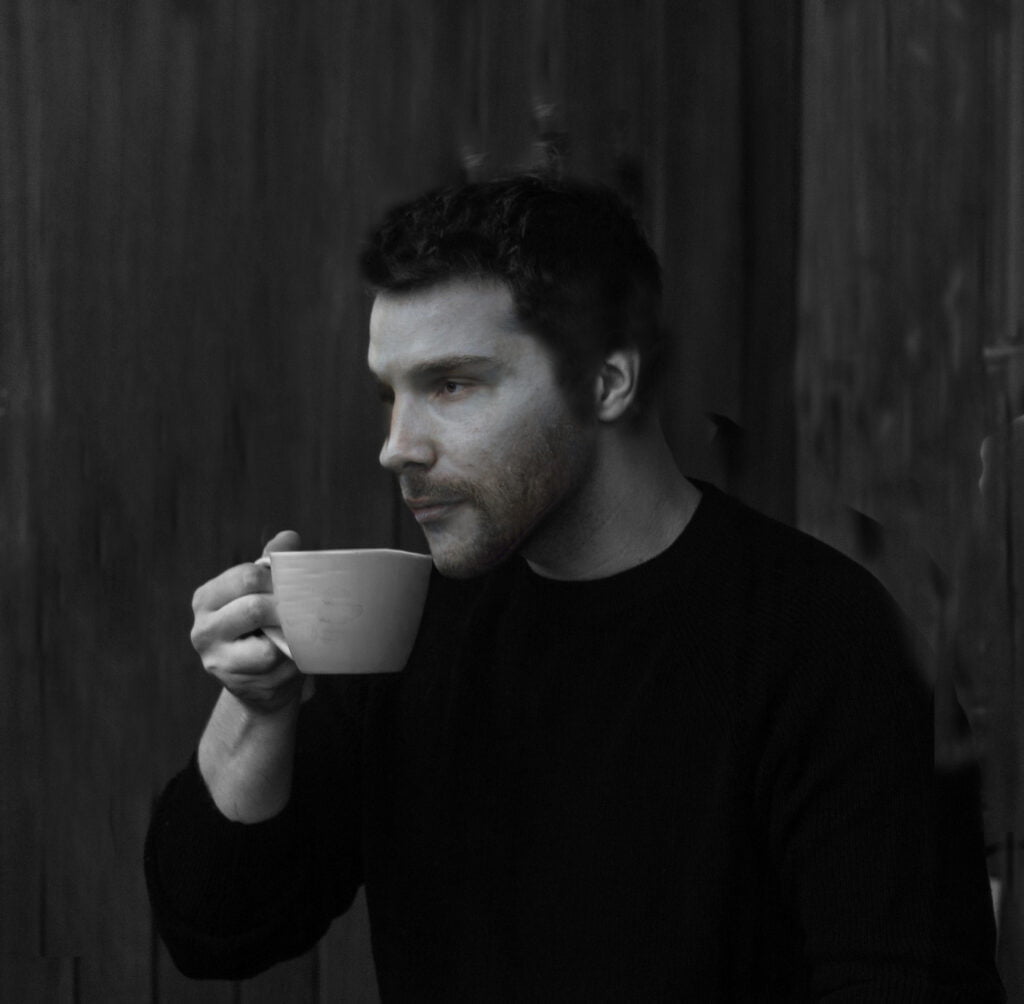Espresso and French press are the two most popular Coffee Brewing methods yet they offer two completely different coffee experiences.
Espresso produces a small, intense shot of coffee by forcing hot water through finely ground beans under high pressure. In contrast, the French press involves steeping coarsely ground coffee in hot water for several minutes, resulting in a rich, full-bodied cup of coffee.
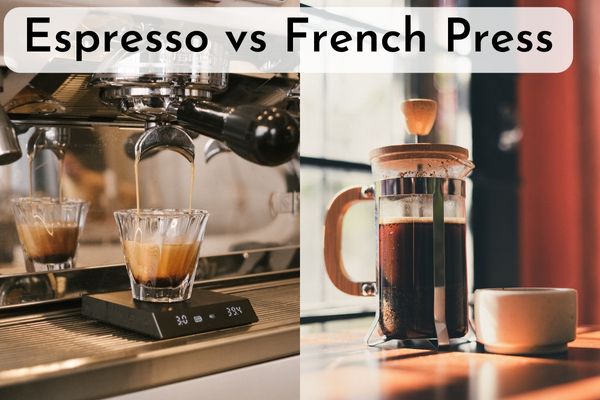
An Overview of the Espresso Brewing Method
Espresso is a popular coffee brewing method that originated in Italy in the early 20th century. It involves forcing hot water through finely ground coffee beans under high pressure, resulting in a concentrated shot of coffee topped with a light brown crema layer.
The preparation of espresso involves a significantly high coffee-to-water ratio of 1:2, which requires 7 to 9 grams of coffee grounds to yield a mere one-ounce shot.
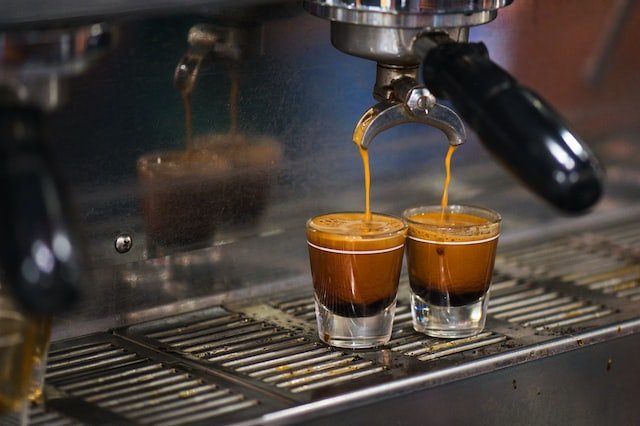
Here are some of the pros and cons of the espresso brewing method:
Pros of Espresso over French Press
- Flavorful and Intense: Espresso is known for its rich, intense flavor and aroma, attributed to the high-pressure brewing method that efficiently extracts oils and flavors from the coffee beans.
- Crema: Espresso shots are crowned with crema, a creamy, frothy layer that lends a delightful texture and visual appeal to the shot.
- Versatile: Espresso can be enjoyed on its own or used as the base for a variety of other drinks, such as lattes, cappuccinos, and Americanos to name a few.
- Quick and convenient: The espresso brewing process is very quick, generally taking only 20 to 30 seconds to yield a shot. This efficiency makes it a well-suited option for busy coffee cafes.
- Lower acidity: The espresso brewing process counteracts the harsh acidic notes in coffee, leading to a more balanced and less acidic taste experience.
Cons Of Espresso
- Expensive: A Good Espresso machine costs above 500 dollars while High-end models may cost above 1000 dollars. In addition, repairs and maintenance can be costly because of the intense pressure required for the brewing process.
- Skill required: The ability to make an excellent shot of espresso isn’t everyone’s cup of cake it does require some expertise. It can require effort and perseverance to perfect the grind size, tamping pressure, and extraction time.
- Less Quantity: Espresso shots usually are minimal, between one and two ounces, which may not satisfy some coffee enthusiasts who want a longer and full coffee experience.
- Bitterness: Espresso has concentrated flavors that, if not appropriately brewed, can taste unpleasant or overly bitter.
An Overview of the French Press Brewing Method
The French press is an immersion coffee brewing method that involves soaking coarsely ground beans in hot water and pressing the coffee through a metal filter to make a full-bodied and flavorful drink.
Since its invention in the early nineteenth century, it has become a popular home brewing method all over the world, also known as a Press Pot or Cafetiere.
French press coffee uses a coffee-to-water ratio of 1:15 to 1:18, with coarsely ground beans steeped in hot water for a duration of 4 to 6 minutes.
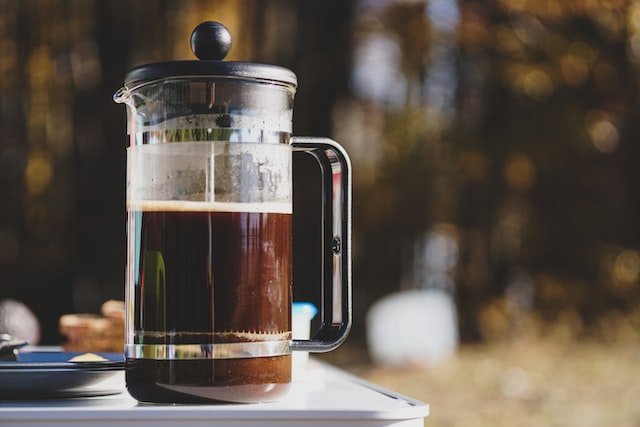
Pros Of French Press Over Espresso
- Full-bodied flavor: The French press method allows more oils and flavors to be extracted from the coffee beans as there are no paper filters involved in the process, resulting in full-bodied and strong flavors.
- Affordable: French presses are relatively inexpensive compared to other coffee brewing methods, making them an excellent option for budget-conscious coffee drinkers. You can easily get a good French Press for under 30 bucks.
- Easy to use: French presses are simple and require minimal equipment. You only need a French press, hot water, and coffee grounds to brew a perfect cup of coffee.
- Customizable: French Press allows you to have more control over the brewing process. You can adjust the grind size and steeping time to suit your taste preference.
- Versatility: In addition to hot coffee, you can also use French Press to make Iced Coffee, cold brew coffee, and tea.
- Portability: The French press is a portable and convenient way to brew coffee at home, at work, or on the go. You can easily pack a French press and some coffee beans for a camping trip or weekend getaway.
Cons of French Press
- Time-consuming: The French press takes several minutes to prepare, steep, and press the coffee, making it less convenient for those in a hurry. From Beans to brew it can take around 10-15 minutes to prepare coffee.
- Requires attention: The French press requires careful attention to the brewing time and water temperature to achieve the best results. If the water is too hot or the coffee is left too steep for too long or the coffee grounds are fine, it can result in a bitter-tasting or muddy cup of coffee.
- Inconsistency: French press can be a somewhat inconsistent brewing method since the variables involved in the brewing process (coffee grounds, grind size, steeping time) can vary from one batch to the next.
- Sediment: The French press uses only a metal filter, so some sediment passes into the coffee drink. This can be off-putting for some coffee drinkers but loved by others as it gives a rich mouthfeel.
- Fragility: Most French presses are made of glass, which can break easily if mishandled. Additionally, the metal filter can become bent or damaged over time, requiring replacement.
French Press vs Espresso | Head-to-Head Comparison
Here are some of the main differences between Espresso and French Press coffee
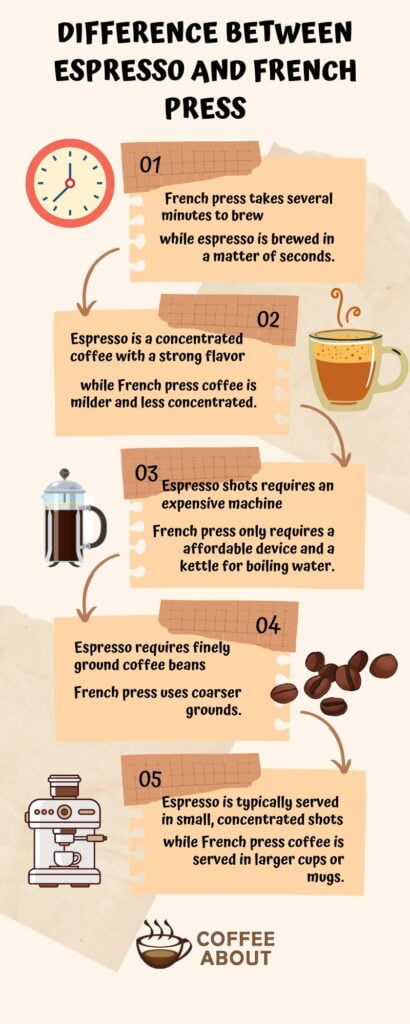
1) Taste and Flavor Profile
Espresso is a concentrated and strong coffee with a bold flavor and creamy texture. Its flavor profile is notably complex and has very low acidity.
The Crema layer gives the shot a rich and velvety texture that coats the mouth wonderfully. When brewed with dark roasted beans, it is filled with satisfying notes of chocolate, caramel, or nuts.
French press coffee has a smooth and delicate flavor profile compared to Espresso. Since the mesh filter allows oils and sediments to flow through, the mouthfeel of French press coffee is thick and almost creamy.
I prefer French Press Coffee over Espresso shots since it gives me a more satisfying and leisulry coffee experience. I also love to have concentrated shots of Espresso sometimes.
2) Roast and Grind Size
Espresso requires a finer grind size, as it extracts the coffee quickly under high pressure, while French Press needs a coarser grind size to prevent sediment from ending up in the coffee.
Both French Press and Espresso methods generally use darker roasts due to their robustness and ability to stand up to intense extraction methods.
The Longer roasting increases the natural oils in the beans. These oils lend a thicker body and mouthfeel that suits the intense nature of Espresso and French press coffee.
3) Quick and Ease of Use
Espresso is an extremely quick brewing method, as it takes only 20-30 seconds to brew a shot, while French Press takes 4-6 minutes to steep and press the coffee.
To brew a perfect cup of coffee, both French Press and Espresso require some brewing skills and expertise. Otherwise, you will end up with a terrible drink.
4) Milk-Based Drinks
The concentrated and intense flavor profile of Espresso pairs exceptionally well with milk. Its strong, bold taste stands out even when mixed with milk and sweeteners, creating a harmonious balance between the coffee and the dairy.
The high-pressure extraction of Espresso ensures that its flavors cut through the milk, offering a strong coffee base for popular drinks like lattes, cappuccinos, and macchiatos.
In addition to milk, Espresso is also incorporated with whipping creams, Ice creams, or flavored syrups. In fact, there are 30 types of Espresso Drinks enjoyed around the World.
French Press coffee is known for its smooth and full-bodied flavor, which is best savored without milk. Nevertheless, it can be used to prepare a flavorful milk based Cafe Au Lait.
5) Caffeine and Calories
A regular serving of Espresso has around 60-72 mg of caffeine while a regular serving of French Press coffee has around 120-133 mg of caffeine.
Bear in mind, that an Espresso shot is only 1 oz while a serving of French Press is around 8 oz.
So we can say that Espresso contains much more caffeine per ounce than French Press.
The amount of calories in straight Espresso shots and Black French Pres coffee drinks is almost negligible. It’s the milk and sweeteners that shoot up a number of calories.
6) Which is a healthier Option?
Coffee, in general, contains antioxidants and other compounds that have been linked to several potential health benefits, such as boosting energy levels, and reduced risk of cardiovascular disease, diabetes, and certain types of cancer.
French press coffee tends to contain more Cafestol and Kahweol, which are natural compounds found in coffee that have been associated with increased levels of LDL cholesterol.
Espresso is considered healthy compared to French Press as it contains less Cafestol and Kahweol due to the shorter brewing time. However, the short serving size can lead people to consume more espresso shots at a time, which is unhealthy.
Excessive caffeine consumption can cause increased heart rate and blood pressure, causing insomnia, and triggering anxiety and jitters in some individuals.
Read a detailed guide on whether French Press is good or bad
7) Equipment Required
For espresso, you’ll need an espresso machine that can generate enough pressure (around 9-10 bars) to force hot water through those finely ground coffee beans. In Addition, you’ll need a grinder to grind the beans to perfect fine settings and ideally a milk frother to prepare frothy Latte and Cappuccino drinks. There are a lot of other accessories you can add to make your Espresso set up fancier like special tampers and distributers, cup warmers, different portafilter baskets, etc.
On the other hand, the French press is all about simplicity. All you need is the press itself (basically a fancy cylindrical beaker with a plunger and mesh filter), a kettle to heat up some water, and ideally a burr grinder to get those coarse, even grounds.
8) Cost
In general, French press coffee makers are far less expensive than espresso machines, with good models available for under $30.
On the other hand, Espresso machines are expensive and can cost more than $200 for a basic model to several thousand dollars, depending on the type and features.
9) Portability
French Press coffee makers are portable devices, which makes them your perfect traveling companion.
One of the things I really like about French presses is that they can be used wherever you want whether it’s your kitchen, living room, garden, or hiking trips.
On the other hand, Espresso machines are heavy and confined to one place. However, portable Espresso makers are also available to prepare Espresso-like coffee anywhere.
French press Or Espresso | So, What’s right for you?
Well, I’ve gone in-depth on the French Press vs Espresso debate. When you get down to it, both brewing methods have their pros and cons.
If you want an intense coffee experience go with Espresso. Espresso gives you an ultra-bold, rich shot of pure coffee flavor packed with crema. Espresso is also the best choice if you are into milky Latte and Cappuccino drinks.
If you like delicate flavors and a full serving of coffee go with French press. French press delivers a full-bodied drink that highlights the coffee’s natural flavors. In addition, French Press coffee makers are very simple, portable, and affordable.
Both methods can produce delicious coffee, and it’s worth experimenting to find the one that’s right for you.
Personally, I love French Press coffee as it is rich and full-bodied, but I prefer espresso shots for making milk-based coffee drinks.
What’s your go-to caffeine kick? Share your thoughts in the comments below, and let’s keep the coffee conversation going!
Also Read Other French Press And Espresso Comparisons
- French Press vs Keurig
- Percolator vs French Press
- French Press vs AeroPress
- Espresso vs Drip Coffee
- Moka Pot vs Espresso
FAQs
Is Espresso Or French Press More Popular?
Espresso is increasingly widely available in cafes and eateries worldwide making it the most popular commercial coffee brewing method.
On the other hand, the French press is popular for home coffee drinkers, particularly in North America and Western Europe.
Can you make Espresso in A French Press coffee maker?
No, you can’t prepare authentic Espresso in a French Press coffee maker since Espresso requires pressure during brewing.
But you can make dense and concentrated Espresso like Coffee in a French Press.
